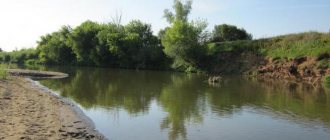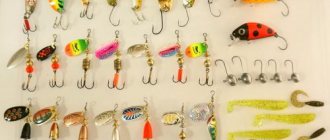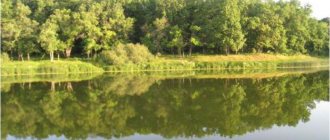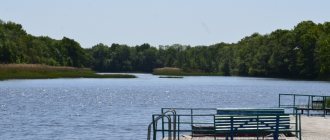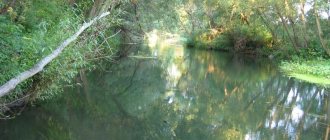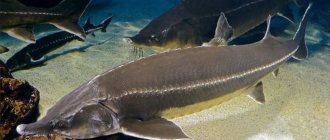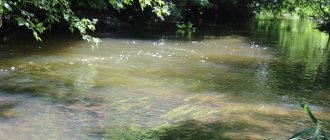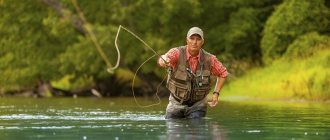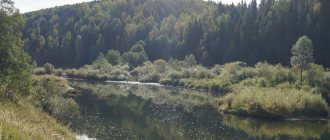The Kuban River is the largest in southern Russia with a length of 662 km and has a huge number of tributaries.
Main tributaries:
- Urup;
- White;
- Laba.
Then they flow into lakes, various irrigation canals and ponds, which over time have become covered with dense thickets of reeds.
Many holes and rifts here have created conditions for comfortable living and successful hunting of predatory species, such as:
- som,
- pike,
- asp,
- chub,
- ide.
Since ancient times, the Kuban River has attracted fishing enthusiasts.
According to confirmed information, it has about 106 species of different fish, for example, such as:
- carp,
- som,
- zander,
- perch,
- mullet,
- carp,
- bull,
- pike,
- silver carp,
- roach.
Therefore, fishing here is considered very popular and varied. Although such a passion for fishing is not a very simple matter here! The Kuban River is quite wide and the current on it is so strong that sometimes you have to repeatedly cast the donk and select the necessary sinker so that it does not get carried away by the force of the water. But in any case, fishing here is a very interesting and exciting activity. Almost no one leaves this river without a good trophy!
Fishing spots
Depending on the specifics of a particular area, fishing on the Kuban River has its own characteristics. In the upper reaches of the river, the water is quite clean, thanks to the melting of the glacier.
And in the flat areas located here it is muddy, which, by the way, does not mean that fishing is inappropriate. The fish adapts well to certain conditions and feels great.
There are fishing bases on the Kuban River. Specially equipped and selected places can significantly save time and not waste it searching for new fishing spots.
So Kuban can be considered an excellent fishing place, or simply a paradise for both fishermen and fauna.
Fishing on the Kuban River. Temryuk area
Temryuk is a wonderful place for those who love fishing and sports recreation. Not far from Temryuk, numerous estuaries and floodplains originate. The estuaries intersect each other with narrow channels and artificially constructed canals.
Fishing in such places is a real pleasure! To sit comfortably on the shore of the estuary, with a fishing rod, is the true embodiment of any fisherman’s dream.
There are many places for fishing in the Temryuk area, these are basically all the reservoirs between the road to Temryuk and the Sea of Azov. The canals in Golubitskaya and in front of the Maly Akhtanizovsky Estuary, in the area of Peresyp, and the Bolshoi Akhtanizovsky Estuary are most in demand.
It is better to fish on canals from the shore, and in estuaries - on the water from a boat.
Here is an incomplete list of the catch that can be caught in the Temryuk area:
- carp,
- crucian carp,
- tench,
- carp,
- rudd,
- roach,
- bream,
- perch
- and pike.
Among fishing enthusiasts there is a very popular base called “Temryuchanka”.
It is located in the delta of the Kuban River, about 13 kilometers from Temryuk. The necessary conditions for relaxation and excellent fishing have been created here!
The Kuban River delta has many tributaries that flow into numerous lakes and water channels with unique fauna and flora.
The variety of fish that lives in the River Delta gives every angler the opportunity to get real pleasure and a lot of impressions from such an activity as fishing!
Most of the reports provided by fishing enthusiasts are positive. Fishermen enthusiastically talk about their trophies and the gear they used in this or that case.
According to their stories, the fishing process itself is quite different from fishing in other regions. For example, the advantage of fishing here is the use of a green worm as bait (you can get it right near the water), which can be used to catch large pike perch, catfish or perch!
In addition, if you choose the right time for fishing, then your catch, even with a simple fishing rod, with any bait, will undoubtedly please you. Pike, perch, crucian carp and rudd - this is an incomplete list of successful fishing in the Kuban.
Features of the catch
The Kuban River originates in Karachay-Cherkessia, its length exceeds 900 kilometers. It has several large and small tributaries. It is known that more than 150 species of fish live in the river; of course, not all of them are of commercial importance. There are a lot of holes, pools and riffles in the river. Such conditions are excellent for predators and peaceful fish. The following species are found in the river :
- som,
- carp,
- zander,
- perch,
- mullet,
- silver carp,
- asp,
- chub,
- saberfish,
- roach,
- shemaya,
- pike,
- carp,
- ide.
The river stretches for several hundred kilometers. It changes its relief several times. That is why fishing in different areas has its own characteristics.
Fans of chub and Kuban barbel go to the upper reaches of the river. After the weather warms up, fishermen with spinning rods and fly fishing come to the river bank. They return home with a large catch of chub. But to catch Kuban barbel they use bottom gear . It is worth remembering that the river current in this place is very strong, so you need to use sinkers. Otherwise, the water will carry away all the gear.
The flat areas of the river are attractive for carp fish lovers. In these places you can find bream, crucian carp, carp, carp and roach. Crucian carp lovers go to the river bays. It is there that you can catch large specimens, but they are quite cautious, so fishing can last several hours.
Carp lovers also respect fishing on the Kuban River. Of course, in this river there are no such large specimens as in the Volga or Akhtuba, but many fishermen managed to catch fish weighing more than 10 kilograms. To catch carp, makushankas and feeders are most often used.
Bream is considered the most coveted catch on the Kuban plains. Individuals reach very large weights due to the rich food supply. Fishermen use bait to catch bream. Most often they mix steamed grain and worms with soil. Bream bite well on worms and maggots.
The lower reaches of the Kuban are a real paradise for lovers of predators. It is known that even a beginner can catch pike in this reservoir. It bites well not only on live bait, but also on artificial baits. In the river you can catch very large individuals weighing more than 3 kilograms. Pike and perch can be caught at any time of the year . Bream in the lower reaches of the river is active only in the spring, so lovers of this fish go fishing from March to May. On cold and rainy days, fishermen may catch tugun. This predator is famous for its very tasty and tender meat. There are individuals in the river whose weight approaches 10 kg.
River fish
Kuban, flowing into the Sea of Azov, formed a large delta, with favorable conditions for the habitat of many varieties of fish. Some fish adapted to living in the sea, while others went to fresh waters. Thanks to the mild climate and the diversity of zooplankton, fish grow very well here and also spawn.
Upper river
In the upper reaches of the river, the water is clean, transparent and fast flowing. Its main inhabitants are the Caucasian chub and barbel. The chub is a strong fish that lives near the sources. To catch chub, spinning rods or fly fishing methods are used. And barbel can only be caught using bottom gear.
In the flat part of the river
After descending from the mountains, on the flat part of the river, a family of carp appears:
- Bream,
- roach,
- carp,
- carp.
Bream is a large fish and is very popular among fishing enthusiasts. In river bays where there is no current, crucian carp live, hiding in nondescript coastal places.
A quiet and calm habitat has a beneficial effect on this fish, and it reaches a kilogram weight. But due to the high and dense thickets of the bay, it is difficult to catch it.
Let's talk separately about the carp, which has a decent size. They catch it using the makushanka method, although the most avid fishermen prefer it with a feeder or carp fishing gear.
History of the development of the Kuban River
The Kuban River flows into two seas at once - the Black and Azov. In the 19th century, most of the flow fell into the Kiziltash estuary and went into the Black Sea. Now, after draining the delta and strengthening the branches, almost all the water flows into the Temryuk Gulf of the Sea of Azov.
Few sources of water can compare with it in the number of ancient names. If you count those that have survived to this day, it turns out that there are more than three hundred of them. What is the secret of such diversity? In the rich history of the region! People have lived here since time immemorial, one tribe replaced another, and each gave the main water artery its own name.
The neighbors also contributed - each ancient chronicler distorted the name he heard from merchants or ambassadors in his own way. But it was they, the ancient Persians and Greeks, who left the first descriptions of the Kuban River.
Now historians find different toponyms among the Cimmerians and Scythians, Pechenegs and Cumans, Huns and Khazars, Greeks and Romans, Bulgars and Tatars, Turks and Genoese, Arabs and Persians, Slavs and mountain tribes. The latter had more dialects than all the above-mentioned peoples combined, and each dialect had its own name.
The river gave its name to the whole region, as well as to one of the largest military classes in Russia, settled on its banks - the Kuban Cossacks. It was formed in 1860 from other Cossack associations and settled throughout the Kuban region (as this region was called until 1918). This river occupies a lot of place in their folklore; in their songs they affectionately call it Mother River, Kubanushka.
Popular Kuban shemaya
This fish deserves special attention in our article! A very tasty, tender and fatty fish, it has become famous throughout the country for its taste of meat. Many people come specifically to fish there.
The Kuban shemaya belongs to the carp family. An adult fish reaches thirty centimeters in size and increases its weight to 200 grams. It feeds on zooplankton and small species of other fish.
This fish is schooling and can be caught using a wide variety of float gear. From the Sea of Azov, during spawning, the shemaya enters the Kuban. The number of fishermen immediately increases, they literally litter the banks of the river. And it becomes clear that shemaya has gone!
Bream fishing
A favorite pastime in the Kuban delta is bream fishing. The bream living on the plains is much smaller than this. Bream often migrates, and even swims to some parts of the Sea of Azov. It is caught mainly from a boat or with bottom gear and wiring.
Important! The current in the Kuban is strong and carries away bottom gear, so the sinker must be quite heavy.
The main signs of bream habitat are:
- The presence of a cliff with deep places underneath;
- Presence of shells on the shore. Shells are food;
- Artificial buoys indicating deep places.
You can catch bream all year round.
Bream is a shy fish, so it requires a special approach:
- You need to feed the same place with bait so that as many fish as possible accumulate there and the bream does not smell the trick;
- Choose feeders according to your chosen fishing location;
- The peculiarity of feeder fishing is not only the choice of fishing location, the accuracy of casting, but also the selection of different flavors of bait. And if the fish “believed” you and started feeding you, then you did everything right.
You can catch bream both from the shore and from the water - the choice is yours!
Fish for every taste
Shemaya lovers often go to Kuban. This small fish is famous throughout Russia for its tender meat. Very often fishermen from the Volga region or the Urals come for it. The average weight of an individual does not exceed 200 grams, so fishermen are forced to spend a lot of time catching fish for dinner. Schools of fish swim into the river during spawning. At this time, the number of fishermen on the banks increases several times. Most of them use regular float rods.
Bream fishing is carried out in the Kuban throughout the year. There is especially a lot of fish in the river delta. The largest specimens are found there. There are several signs of the abundance of bream in a reservoir:
- presence of shell rock on the shore,
- the presence of cliffs near the coast,
- uneven bottom topography.
Bream is considered a very shy fish , so lovers of this species use several tricks. They try to lure as many individuals as possible to the fishing site. When among its own kind, bream actively bites. When catching this species you need to use a lot of bait. Most often, anglers use corn, dough and steamed wheat. Vanillin is considered the best flavoring for bait.
Chekhon lives in almost all areas of the Kuban . Individuals of this species gather in large flocks. Most often they can be found near the islands. Fishing for sabrefish takes place in complete silence. If a fish hears a noise, it immediately goes deeper. This is why you have to fish from the shore. Chekhon's favorite delicacy is frogs. That is why fishermen are forced to spend time catching these amphibians. To catch saberfish you need very small frogs.
Catfish has always been considered the king's fish .
In the Kuban River you can find individuals whose weight exceeds 50 kilograms. Of course, not every angler comes across such large specimens. This fish can be caught both from the shore and from a boat. When fishing from a boat or boat, you need to use anchors, as the current is very strong. Mole crickets, small crucian carp and green worms are used as bait. Most often, fishermen use bottom gear with strong fishing line. And also when fishing you need a landing net. Without it, it is difficult to remove even a small catfish from the water.
Fishing on the Kuban River for sabrefish
The sabrefish fish is numerous and lives everywhere on the Kuban River. Schooling fish of the carp family, saberfishes, often stand over various islands in whole schools and wait for some insect to fall into the water and be eaten. Catch sabrefish on a spinning rod or donka.
Interesting:
- You are guaranteed to catch sabrefish if you use a frog. This may surprise you, but this is a favorite delicacy for saberfish. The only clarification is that the frogs must be small in size.
- In order to catch saberfish, you need complete silence; at the first noise, it will go to the depths. Therefore, it is better to catch it from the shore, as it will be quite noisy on the boat.
Popular message topics
- Tree (Deciduous)
Trees are the largest plants on earth. All trees, like plants, have roots, a trunk and leaves. Deciduous trees are called that way because they are covered with leaves. - Yakuts
Yakuts are the indigenous people of Siberia. They call themselves “Sakha”; several residents call themselves “Sakhalar”. Children from mixed marriages of Yakuts and Europeans are called “sakhalyars”, not to be confused with “sakhalars”. - Underwater world
If you look at the world map, you can see that there is a lot of blue on it. These are rivers, seas, oceans. And more than half of the animals, plants and fish live in them. The nature of the underwater world is very amazing.
Catfish fishing on the Kuban River
Catching catfish is every angler's dream! This large fish reaches 60 kilograms here.
Catfish are most active in the morning at about 10 o'clock and in the evening. It is often caught in holes at great depths or from a boat with a hard bottom. But there is one important aspect here - you will need to stock up on anchors, since the current is very strong.
Fishing for catfish is carried out on the bottom, and you can choose any bait, but mole cricket and crucian carp are considered the best. You can also fish for catfish by baiting a green reed worm - the most common bait on the Kuban River. Important: when catching catfish, be sure to use a landing net, since even a small fish will be difficult to drag into the boat without it!
Fishing for sabrefish in the Kuban
Chekhon stays in schools in large sections of the river with a fast current. As a rule, fish swim at considerable depths, so searching for them in flood lakes and floodplains will be fruitless. Only on hot days does the fish come closer to the surface of the water surface. Closer to winter cold, sabrefish reaches a depth of 14-16 meters from the bottom surface.
A massive movement of fish is observed in the spring months. During this period you can expect:
- near pits;
- on the shallows;
- in areas of elevated bottom surface.
In the hot summer, it is more advisable to fish sections of the river:
- with a clear boundary between fast and slow currents;
- near the entrances and exits of deep pits.
Suitable baits include worms, caddis flies and maggots. You can also attach a fly, gadfly, wasp, wobbler, twister or vibrotail to the hook. If the task is to catch a large sabrefish, then you cannot do without a fry with a size of about 4 cm.
When feeding a selected area of the reservoir, we systematically throw in portioned pieces of food, which will keep the fish at the fished point for a long period of time.
Let's celebrate! When using feeder tackle, you should add a loosening component (for example, coconut flakes) to the bait. It is also recommended to include a small part of the bait used for fishing in the bait composition.
Fishing for chub and podust on the Kuban River
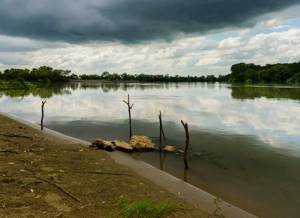
The most promising fishing for such large fish as chub is fishing with a wobbler or spinner.
The chub is a “fighting” representative of the carp family; it often emerges as the “winner” and gets off the hook. August and September are the best times for chub fishing. Its greatest activity occurs during the day when the sun is shining.
Catching chub requires the ability to accurately cast a spinning rod without disturbing the silence. To prevent the chub from leaving, you need a stronger rod and a stronger spinning rod. And then a successful catch is guaranteed to you!
Podust habitats are mainly rifts, unevenness and gullies made of sand and clay. The greatest bite of this fish is in May and June. The bait can be worms, maggots, rolled algae balls, and bark beetle larvae. Podust are caught using float or bottom gear.
Economic use
- River water is used by local residents for domestic needs.
- The river has large hydropower resources. The Kuban cascade of hydroelectric power stations provides the regions with electricity with a capacity of 620 MW. The Kuban cascade of hydroelectric power stations consists of three groups of hydroelectric power stations: Kurshavskaya, Barsuchkovskaya and Sengileevskaya.
- Water is necessary for the activities of industrial organizations.
- The Krasnodar reservoir was built in the lower reaches - a key element in the development of economic activity in the south of Russia. The purpose of the artificial reservoir is irrigation of agricultural land, flood control, and recreation. In addition, the reservoir finally regulated the flood flow and provided the opportunity to increase the volume of rice sowing.
- The reservoir is used as a fishing and fish-breeding reservoir. For this purpose, the Ryazan spawning and breeding farm was created and fish hatcheries were built.
- River waters are used to create optimal salinity for fish breeding in the Sea of Azov.
